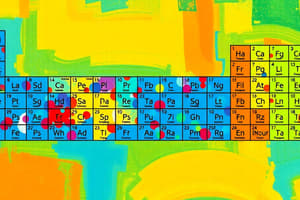Podcast
Questions and Answers
How does the effective nuclear charge (Zeff) change within a period on the periodic table?
How does the effective nuclear charge (Zeff) change within a period on the periodic table?
- It remains constant across the period.
- It increases from right to left.
- It decreases from left to right.
- It increases from left to right. (correct)
Which of the following correctly describes the size of cations compared to their parent atoms?
Which of the following correctly describes the size of cations compared to their parent atoms?
- Cations are larger due to added electron repulsion.
- Cations are smaller because outer electrons are removed. (correct)
- Cations have an increased ionic charge that enlarges them.
- Cations are the same size as their parent atoms.
In an isoelectronic series, what trend is observed in ionic size as nuclear charge increases?
In an isoelectronic series, what trend is observed in ionic size as nuclear charge increases?
- Ionic size remains unchanged regardless of nuclear charge.
- Ionic size fluctuates unpredictably with nuclear charge.
- Ionic size increases with increased nuclear charge.
- Ionic size decreases with increased nuclear charge. (correct)
What happens to the atomic radius as you move down a group in the periodic table?
What happens to the atomic radius as you move down a group in the periodic table?
What is defined as the distance between two nuclei in a bond?
What is defined as the distance between two nuclei in a bond?
How does ionization energy generally change across a period?
How does ionization energy generally change across a period?
Which of the following statements about anions is correct?
Which of the following statements about anions is correct?
Which of the following trends is true for the atomic radius within a period?
Which of the following trends is true for the atomic radius within a period?
What is the primary reason for the increasing ionization energy as you move left to right across a period?
What is the primary reason for the increasing ionization energy as you move left to right across a period?
What observation is made regarding metallic character as you move down a group in the periodic table?
What observation is made regarding metallic character as you move down a group in the periodic table?
Flashcards are hidden until you start studying
Study Notes
Development of Periodic Table
- Elements in the same group have similar chemical properties, although their physical properties may differ.
- Dmitri Mendeleev and Lothar Meyer independently discovered the periodic law, concluding that elements should be arranged based on their properties.
Periodic Trends
- Periodic trends refer to the patterns observed in the properties of elements across the periodic table.
- Trends include:
- Effective nuclear charge
- Atomic and ionic size
- Ionization energy
- Electron affinity
- Metallic character
Effective Nuclear Charge (Zeff)
- In a many-electron atom, electrons are both attracted to the nucleus and repelled by other electrons.
- The effective nuclear charge (Zeff) experienced by an electron is the net positive charge it feels after accounting for shielding effects.
- Zeff increases from left to right across a period due to increasing nuclear charge (protons) and constant shielding.
- Zeff increases from bottom to top within a group due to decreasing principal quantum number (n) and stronger nuclear attraction.
Atomic Size
- Atomic radii tend to increase from right to left across a period due to decreasing Zeff, allowing electrons to occupy larger orbitals.
- Atomic radii increase from top to bottom within a group due to increasing principal quantum number (n), resulting in larger electron shells and orbits.
Sizes of Ions
- Cations are smaller than their parent atoms because the loss of an electron reduces electron-electron repulsions.
- Anions are larger than their parent atoms because the addition of an electron increases electron-electron repulsions.
Isoelectronic Series
- In an isoelectronic series, ions have the same number of electrons but different nuclear charges.
- Ionic size decreases with increasing nuclear charge within an isoelectronic series due to stronger attraction between the nucleus and the electrons.
Bond Length
- Bond length is the distance between two nuclei in a molecule.
- Larger atomic radii lead to longer bond lengths.
Ionization Energy
- Ionization energy is the minimum energy required to remove an electron from the gaseous atom or ion in its ground electronic state.
- First ionization energy refers to the removal of the first electron, while subsequent ionization energies refer to the removal of additional electrons from the ion.
Studying That Suits You
Use AI to generate personalized quizzes and flashcards to suit your learning preferences.




